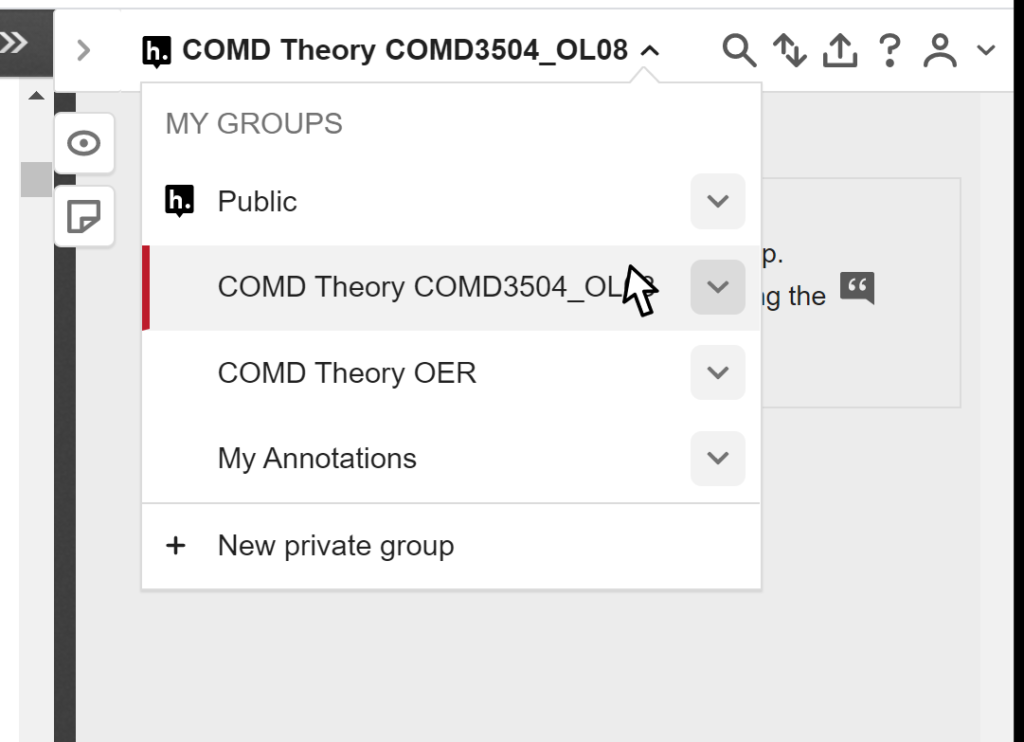Contents
Get Started!
- Visit the Get Started page to create a Hypothesis account.
- Next, install the Hypothesis Chrome Extension.
- If you’re using a different browser simply drag the bookmarklet button from the Get Started page into your bookmarks bar. Note: you need to make sure your bookmarks bar is visible first.
Join our Hypothesis group
- Log into your Hypothesis account.
- Next click the Hypothesis Group Invite link provided to join the group.
- When you are using Hypothesis for this class, be sure to choose our group from the dropdown. That way, all of our annotations are collected in one place.

Learn about Annotation Types
Hypothesis gives you a few different tools to help you annotate a reading. As a general rule, your annotations should add something to what is already in the text. What you contribute will also help your classmates. Here are some suggestions for each type of tool.
The Annotation Tool
Use the annotation tool to select a word or phrase in the text and add notes, images, links to share with the class. When others come across the annotation they can also add an annotation or reply to yours. TIP: You can also use the annotation tool for your own research by choosing “Only Me” when posting.
- Ask a question. Confused by a passage or word? Select it and pose a question to the class.
- Define a word. Did you find an unfamiliar word or a word you don’t understand because of the context? Select it and add a definition plus a link to the source, preferably Websters or similar.
- Add a reference. Is there a word or concept in the reading that you are unfamiliar with? Look it up and provide a link to a website, interview, or video. Or add an image.
- Here’s a tutorial about adding Links, Images, and Videos to your annotations.
- Rewrite a sentence. Sometimes the way a writer communicates a concept can be confusioning or too wordy. Rewrite the sentence in your own words after defining unfamiliar words, when necessary.
The Highlight Tool
A highlight is similar to swiping a yellow marker over a passage of text. There are no comments or tags, like the annotation, but it’s anchored in the document and is quoted in the sidebar. A highlight is always private (“Only Me”), which means only you can see it, and only when you’re logged in.
- Important concepts
- Quotations
- Statistics
Page Notes
A page note has similar functionality to an annotation, but it associates comments, images, links, and/or tags with the whole document, not an individual word or phrase. Like Annotations, you can make Page Notes private by choosing “Only Me” when posting.
- Prompts / Questions. Your professor may use a page note to provide a list of prompts or questions for your reading response.
- General Questions or Ideas. If you have a question or thought about the reading as a whole, you might leave it a page note for the class.
- Associated Texts. If there are other texts that you think relate, you might add a page note with links to those texts.
Replies
A reply can be added to an annotation, highlight, page note, or a prior reply. Use the Reply icon to create a reply. Your reply can include text, links, images, and/or tags.
- Ask or Answer a Question. A reply is a great way to communicate with your classmates and discuss the reading as you go along.
- Responding to your own annoations. It’s also a good way of replying to your own highlights, annotations, and notes with additional thoughts as you learn more.
Start Annotating
- Make sure you are logged into your Hypothesis account.
- Navigate to a webpage to annotate.
- Activate the Chrome extension by pressing the greyed-out h. button on your Chrome extensions bar.
- Alternatively, select the Hypothesis Bookmarklet from your Bookmarks bar if you are using another browser.
- NOTE: You can toggle Hypothesis on and off by clicking on the extension or bookmarklet.
- Click on the little arrow on the upper right to extend the Hypothesis tools pop out and choose our group from the My Groups dropdown.
- Select a word or phrase on the page to bring up the Annotate or Highlight icons.
- You may also leave a Page Note by selecting the note icon from the Hypothesis tools popout.
- Learn About Annotation Types above before you start annotating your first reading.
HELP
- Review the QuickStart Guide for Students
- READ Annotation Tips for Students for annotation guidelines.
- READ Taxonomy of Annotation Types for guidence on which type of annoation tool to use.
- More helpful tips from Student Resource Guide
Annotating PDFs
In addition to annotating readings on a website, we can also annotate distributed PDFs that you’ve downloaded to your computer.
- Refer to this Annotating PDFs Tutorial for instructions on how to set up the Chrome Extension to allow for PDF file annotations in the browser.




Recent Comments